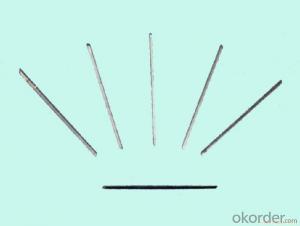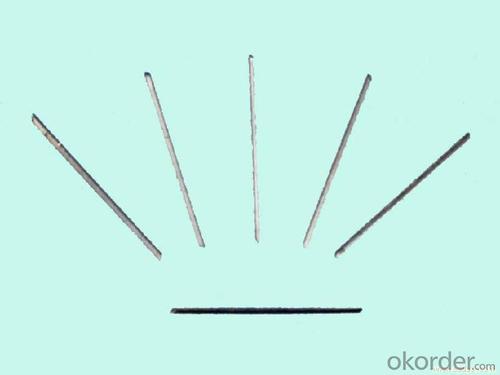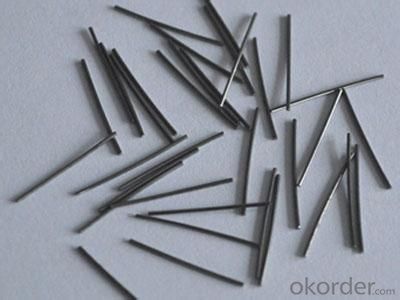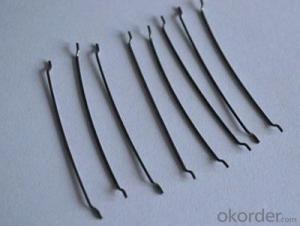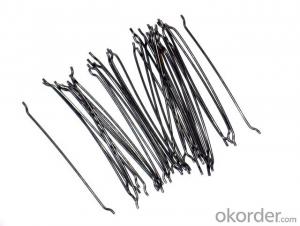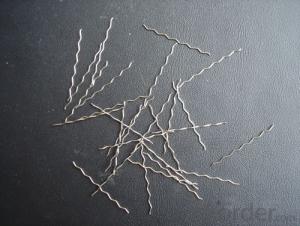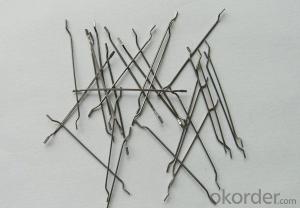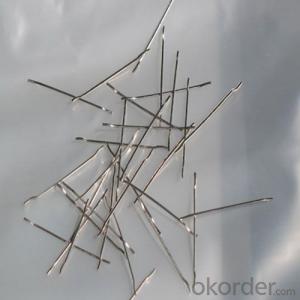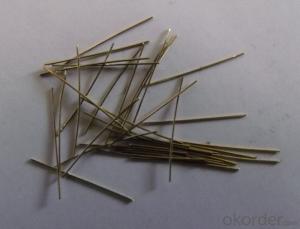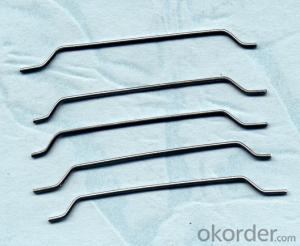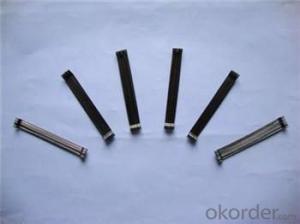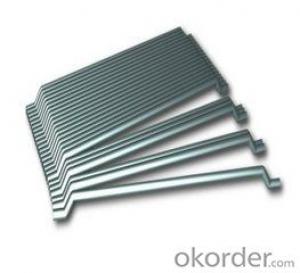Melt Extract Stainless Steel Fiber - Steel Fiber Straight Type CNBM China
- Loading Port:
- Tianjin
- Payment Terms:
- TT OR LC
- Min Order Qty:
- 1000 kg
- Supply Capability:
- 30000 kg/month
OKorder Service Pledge
OKorder Financial Service
You Might Also Like
Quick Details
Place of Origin: Jiangsu, China (Mainland)
Model Number: HT-ST
Material: Steel
Specifications
ISO 9001 certificated
2.70% for Europe, Middle Asia, America market
3.Have the most number of steel fiber machine in china
1. Material: low carbon steel wire or stainless steel
2.Diameter: 0.4mm-1.0mm
3.Length: meet your requirements
4.tensile strength >1000Mpa
6.Feature: excellent tensile,high tenacity,against cracking,impact and fatigue
7.Uses: highway road surface,tunnel,building,airport road surface and so on .
Straight Steel Fiber
1.ISO 9001 certificated
2.70% for Europe, Middle Asia, America market
3.Have the most number of steel fiber machine in china
Picture
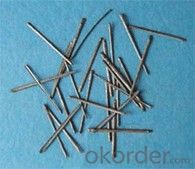
Steel fiber straight type
FAQ
certificated: ISO 9001
Technical advantages of Daye steel fiber:
A. Improve mechanical performance of concrete
B. Provide uniform distribution throughout concrete with excellent mixing
C. No balling or caking by adopt correct mixing method
D. Reduce concrete volume
E.Save construction time and cost
F.Reduce excavation volume
G.Available for jointless floor.
- Q: Can melt extract stainless steel fiber be used in roller-compacted concrete (RCC)?
- Yes, melt extract stainless steel fiber can be used in roller-compacted concrete (RCC).
- Q: Does melt extract stainless steel fiber improve the crack control of concrete elements?
- Yes, melt extract stainless steel fiber does improve the crack control of concrete elements.
- Q: What are the limitations of using melt extract stainless steel fiber in concrete?
- Using melt extract stainless steel fiber in concrete has several limitations. Firstly, the cost of stainless steel fibers is high compared to other types of reinforcing materials. This is because the manufacturing process involves melting and extracting steel, which adds to the overall production cost. Consequently, it may not be cost-effective for projects with tight budgets. Secondly, the addition of stainless steel fibers can make the concrete mix more viscous, making it difficult to handle and place. This can pose challenges during the construction process, particularly when pouring and finishing the concrete. Furthermore, if the stainless steel fibers are not properly coated, there is a risk of corrosion. Although stainless steel is generally resistant to corrosion, it can still be susceptible in environments with high chloride content. This can compromise the durability and longevity of the concrete structure. Moreover, the effectiveness of stainless steel fibers in controlling cracking may vary depending on the concrete mix design and curing conditions. Specific fiber dosages and distribution may be required to achieve the desired crack control properties, adding complexity to the concrete mix design process. Lastly, the addition of stainless steel fibers can impact the aesthetics of the concrete surface. The fibers can be visible on the surface, especially if a smooth finish is desired. This may not be desirable for applications that require a visually appealing finish, such as architectural concrete. In conclusion, while melt extract stainless steel fibers offer benefits in reinforcing concrete, such as increased crack resistance and improved durability, they also have limitations including high cost, increased viscosity of the mix, potential for corrosion, variability in crack control effectiveness, and impact on aesthetics. It is important to carefully consider these limitations when deciding to use stainless steel fibers in concrete applications.
- Q: What is the effect of melt extract stainless steel fiber on the plastic settlement of shotcrete?
- The effect of melt extract stainless steel fiber on the plastic settlement of shotcrete is significant. The addition of melt extract stainless steel fibers to shotcrete helps to improve its overall performance and reduce plastic settlement. Shotcrete is commonly used in construction for its ability to be applied quickly and efficiently. However, one of the challenges with shotcrete is plastic settlement, which refers to the settling or sinking of the material before it sets and hardens. This settlement can lead to cracks, voids, and reduced strength in the shotcrete. Melt extract stainless steel fibers are specifically designed to address this issue. These fibers are added to the shotcrete mix, and during the application process, they disperse uniformly throughout the material. As the shotcrete settles, the stainless steel fibers act as reinforcement, providing additional support and preventing excessive settlement. The stainless steel fibers enhance the tensile strength of the shotcrete, making it more resistant to cracking and deformation. They create a three-dimensional network within the material, increasing its overall structural integrity. This reinforcement effect significantly reduces the plastic settlement of shotcrete, ensuring that it retains its shape and strength during the setting process. Furthermore, melt extract stainless steel fibers also improve the durability and longevity of shotcrete. They help to prevent the formation of shrinkage cracks and provide added protection against external factors such as temperature changes, moisture, and chemical exposure. In summary, the addition of melt extract stainless steel fibers to shotcrete has a positive effect on its plastic settlement. These fibers reinforce the material, reduce settlement, and improve its overall performance, durability, and strength.
- Q: Can melt extract stainless steel fiber be used in highway pavements?
- Highway pavements can benefit from the use of melt extract stainless steel fiber. These fibers are renowned for their robustness and endurance, making them ideal for enduring heavy traffic and harsh environmental conditions. When incorporated into concrete or asphalt mixtures, stainless steel fibers enhance the overall performance of the pavement by bolstering its crack resistance, flexural strength, and fatigue resistance. This, in turn, prolongs the lifespan of the pavement and reduces the need for frequent repairs and maintenance. Furthermore, the corrosion-resistant qualities of stainless steel fibers ensure that the highway pavement remains structurally sound and intact as time passes. Therefore, incorporating melt extract stainless steel fiber into highway pavements is a viable solution for augmenting their durability and longevity.
- Q: How does melt extract stainless steel fiber affect the crack width of concrete?
- Melt extract stainless steel fiber can effectively reduce the crack width in concrete. When added to the concrete mix, the fibers disperse throughout the matrix, creating a three-dimensional reinforcement system. As the concrete sets and hardens, the fibers provide additional tensile strength, preventing cracks from propagating and widening. The fibers act as tiny reinforcement bars, bridging the cracks and distributing the stress across a larger area, thereby limiting crack width. Consequently, the incorporation of melt extract stainless steel fibers in concrete significantly improves its durability and structural integrity.
- Q: What is the effect of melt extract stainless steel fiber on the crack width in shotcrete?
- The use of melt extract stainless steel fiber in shotcrete can effectively reduce crack width by enhancing the tensile strength and ductility of the material. The fibers act as reinforcement, distributing the stress more evenly, and preventing the propagation of cracks. This results in improved crack resistance and overall durability of the shotcrete structure.
- Q: How does melt extract stainless steel fiber affect the thermal conductivity of concrete?
- Melt extract stainless steel fiber can significantly affect the thermal conductivity of concrete. The addition of these fibers to concrete increases its thermal conductivity, meaning that heat can be conducted more efficiently through the material. This is mainly due to the high thermal conductivity of stainless steel, which is much higher than that of concrete. When melt extract stainless steel fibers are mixed into concrete, they act as conductive pathways for heat to travel through the material. As a result, the overall thermal conductivity of the concrete increases, allowing for better heat transfer and distribution. This enhanced thermal conductivity can have various benefits in concrete applications. For instance, in structures where thermal management is critical, such as in high-rise buildings or infrastructure exposed to extreme temperatures, the addition of stainless steel fibers can help regulate and dissipate heat more effectively. This can help prevent the build-up of excessive heat, reducing the risk of thermal expansion and potential structural damage. Furthermore, the improved thermal conductivity of concrete with stainless steel fibers can also enhance the efficiency of heating or cooling systems in buildings. By facilitating better heat transfer, the concrete can act as a more effective thermal mass, absorbing and releasing heat more efficiently, thereby reducing energy consumption and enhancing comfort levels. However, it is important to note that the impact of melt extract stainless steel fibers on thermal conductivity may vary depending on factors such as fiber content, fiber length, and fiber distribution within the concrete mix. Proper design and testing are essential to ensure the desired thermal performance is achieved.
- Q: What is the effect of melt extract stainless steel fiber on the early-age cracking of shotcrete?
- The impact of melt extract stainless steel fiber on the early-age cracking of shotcrete is notable. When shotcrete mixtures incorporate stainless steel fibers, they function as reinforcement, enhancing the material's overall strength and durability. The primary advantage of utilizing melt extract stainless steel fiber lies in its capacity to regulate and diminish early-age cracking in shotcrete. Early-age cracking transpires due to the contraction and settlement of the fresh shotcrete during the curing process. These cracks have the potential to compromise the shotcrete's integrity and performance, resulting in reduced strength and increased permeability. By introducing melt extract stainless steel fibers into the shotcrete mix, these fibers furnish supplementary reinforcement and enhance the material's tensile strength. This reinforcement assists in distributing stresses and strains more uniformly throughout the shotcrete, thereby diminishing the probability and severity of early-age cracking. Moreover, the stainless steel fibers also heighten the cohesion and cohesiveness of the shotcrete mix, rendering it more resistant to shrinkage and settlement. This augmented cohesion aids in minimizing crack formation during the initial stages of curing, guaranteeing a more robust and dependable shotcrete structure. In conclusion, the inclusion of melt extract stainless steel fiber significantly diminishes early-age cracking in shotcrete. It bolsters the tensile strength, cohesion, and overall performance of the shotcrete, resulting in a more enduring and long-lasting structure.
- Q: Can melt extract stainless steel fiber be easily dispersed in concrete mixtures?
- Yes, melt extract stainless steel fiber can be easily dispersed in concrete mixtures. The fibers are typically added during the mixing process and can be evenly distributed throughout the mixture, enhancing the strength and durability of the concrete.
Send your message to us
Melt Extract Stainless Steel Fiber - Steel Fiber Straight Type CNBM China
- Loading Port:
- Tianjin
- Payment Terms:
- TT OR LC
- Min Order Qty:
- 1000 kg
- Supply Capability:
- 30000 kg/month
OKorder Service Pledge
OKorder Financial Service
Similar products
Hot products
Hot Searches
Related keywords
